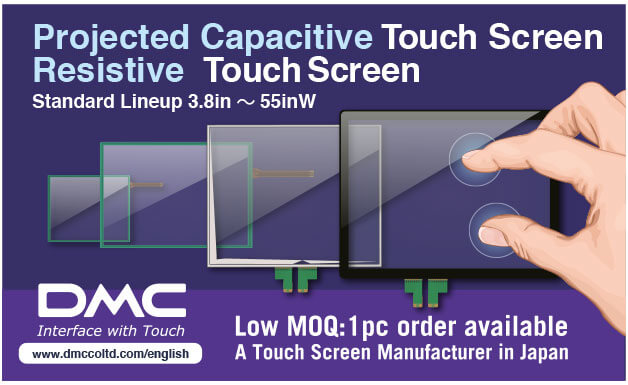To view this YouTube video, permission is required in the Advertising section.
DMC Touch Screens - Several Technologies

analog resistive 4- and 5-wire Touchscreens
DMC's analogue resistive 4- and the more robust 5-wire touch screens are the perfect choice for budget-priced, compact applications.
Glass/glass – technology enables unlimited operation with gloves and resists all cleaning agents. Moreover these touch screens are especially clear, scratch-resistant and are controlled with the usual 4-wire controllers. On a project basis we can provide sizes from 7″ to 19″ and film/glass touch screens.
For further details, please refer to the AST/ATP-Series data sheet for the 4-wire touch screens and to the FST-Series datasheet for the 5-wire touch screens.
The DMC 4-wire touch controller TSC-44 RSA-E (RS232) or TSC-34 RU-F (RS232/USB2.0) and 5-wire touch controller TSC-35 RU and the appropriate cables connect the touch screens with the PC interfaces RS232 or USB. Please click here for the corresponding drivers.
The DMC controller ICs TSC-30/IC and TSC-40/IC are available on request/project basis. They enable a perfect integration of DMC touch screens into your design.
The DMC controller ICs TSC-30/IC and TSC-40/IC are available on request/project basis. They allow you to optimally integrate DMC touch screens into your design.
Projected capacitive PCAP Touchscreens
DMC's 2 - 5 finger projected capacitiven touch screens enable professional optical designs as known from modern smartphones or tablet PCs, both for indoor and outdoor applications. An optional cover glass protects the touchscreen against vandalism.
For technical details please refer to the DUS-series data sheet
The DMC DUS-series touch controller (DUS-1000, DUS-2000, DUS-3000, DUS-4000 and DUS-6100) and the appropriate cables connect the touch screens with the PC interfaces UART or USB.
Please click here for the DUS serie's driver and software.
Optional: Water Detection Function
With this function, the touch screen prevents incorrect operations due to rain and ice by detecting the conductive contaminant.
The touch controller identifies the presence of for example water and rejects all inputs after exceeding a certain threshold. Once the water is wiped off, the touch is working normally again. The protection mode is being reported to the computer via USB, so that a warning can be displayed on the screen to inform the user.
To view this YouTube video, permission is required in the Advertising section.